Post-impressionism (or Expressionism)This designation is actually chronological more than descriptive of a "school" of artists. The artists who are thus categorized often illustrate a subjective, highly personal response to reality. This is seen both in the subjects they choose to depict as well as the style.
|
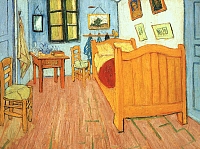
|
 Vincent van Gogh
(1853-90)The Bedroom in Arles, 1887
Van Gogh's subject is unique and personal. He depicts his very ordinary, spartan bedroom. Critics have suggested that his loneliness is conveyed through the pairings of objects--pillows, pictures, chairs; thus, this ordinary scene could have private symbolic resonance. |
These paintings by Van Gogh also convey a symbolic meaning. Both could serve as kinds of portraits of the respective artists: the simple Van Gogh contrasted with the elegant and sophisticated Gauguin.
|
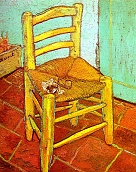 |
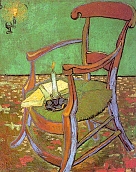
|
Vincent's Chair with Pipe, 1888
Gauguin's Chair with Books and Candle, 1888 |
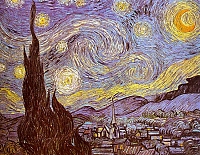
|

The Starry Night, 1889
Expressionism is an extremely personal response to external phenomena; it is strikingly illustrated in van Gogh's famous painting. Marilyn Stokstad explains: "Above the quiet town is a sky pulsating with celestial rhythms and ablaze with exploding stars--clearly not a record of something seen but of what van Gogh felt. One explanation for the intensity of van Gogh's feelings in this case focuses on the then-popular theory that after death people journeyed to a star, where they continued their lives. . . . The idea is given visible form in this painting by the cypress tree, a traditional symbol of both death and eternal life, which dramatically rises to link the terrestrial with the stars. The brightest star is actually Venus, which is associated with love. Is it possible that the picture's extraordinary excitement also expresses van Gogh's euphoric hope of gaining the companionship that eluded him on earth?" (1036-7) |
A similar kind of subjectivity is seen in the works of van Gogh's contemporary Paul Gauguin (1843-1903). He sometimes depicts himself in his self portraits as a martyr or a Christ figure.
|

|
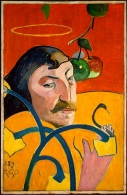
|
Self Portrait with Yellow Christ, 1889-90Self Portrait with a Halo, 1889 |

|
The Day of the Gods, 1894Gauguin's rejection of objective representation is also seen in his use of color; flat patterns of unmodulated color recur frequently in his paintings. The use of a particular color is arbitrary, unrealistic, decorative.
|
Henri Toulouse-Latrec (1864-1903) is another important post-impressionist. Although he made significant stylistic contributions in the history of modern art (especially in his posters), his subjects were also innovative. Often he dealt with the lives of the prostitutes in the Rue des Moulins. Although this is a sordid subject, he depicted these women objectively, without salaciousness.
|
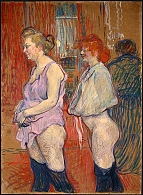
|
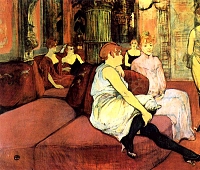
|
Left: Rue des Moulins: The Medical Inspection, 1894Right: At the Salon of the Rue des Moulinsc. 1894 |
Symbolism
Some of these artists above could also be described as symbolists, for they too believed that the inner "fact" is more important than objective reality. They, too, often believed that the role of the artist was not to imitate the real world but to develop their own world in their art through the imagination and a kind of inner vision. One symbolist group even called themselves Nabis, meaning prophets, for they thought the "reality" they discovered was more profound and meaningful than superficial surface "reality." The symbols used by symbolists are not usually traditional (like the dove as a symbol in Christian art for the Holy spirit); rather, the symbolism is private and subjective. Thus, it is often difficult to say exactly what these symbolic works might mean.
|

|
James Ensor
Christ's Entry into Brussels in 1889, 1888The Belgian painter Ensor had a pessimistic view of humankind, often depicting people wearing grotesque masks, displaying stupid smiles, or staring into space. This symbolic painting is also moralizing, for Ensor imagines the kind of response a modern-day Christ would get.
|
 Edvard Munch
The Scream, 1893The Norwegian painter and print maker Munch was obsessed with death, having suffered the deaths of his Mother and favorite sister as a child. One of his self-portraits is entitled Self Portrait in Hell and blood-red recurs in his works. This intense image of fear is Munch's most famous work |

|
The Sleeping Gypsy, 1897
Personal fantasy is important in the works of Henri Rousseau (1844-1910). Essentially untrained, Rousseau depicted an exotic, mysterious world of his imagination. It is not quite clear what this painting suggests. Are we to guess that in the unconscious world of sleep terrors (lions) menace us? |
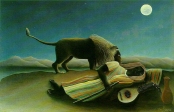
|
FauvesAlthough the Fauves were a short-lived group, their influence was enormous and one of the members of this group, Henri Matisse (1869-1954), is one of the most important twentieth century painters, rivaled only by Picasso. Their style is primarily a variety of expressionism, using bold arbitrary color, distorted forms, rough brush strokes, and violent juxtapositions of color. For this reason their critics called them the Fauves--translated as "Wild Beasts." The banner at the top of this page is from a painting by André Derain, a Fauve artist. Derain uses clashing, non-naturalistic colors: color is used to convey a mood, not to describe an object.
left: Turning Road L'estaque, 1906; right: London Bridge, 1906
|
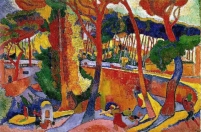
|
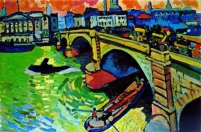 |
Two examples of Matisse's early works are below. In both, Matisse uses arbitrary color and "backgrounds" aren't exactly objectively real backgrounds, but color areas instead.left: Portrait of Madame Matisse (Green Stripe), 1905; right: Open Window, Colliure, 1905
|

|
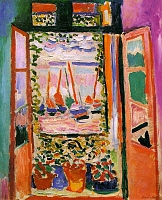
|
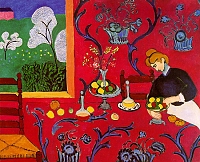
|
 Henri Matisse
Harmony in Red (The Red Room), 1908This painting is typical of Matisse's mature style--colorful, decorative, lyrical. Although the space of the room is suggested by the outline of the table, the chair in perspective, and the window (or is it a framed painting?), still the repeated pattern on the tablecloth and wall and vivid red make the painting seem flat and two-dimensional. The painting is a unified, harmonious whole; even the shapes comprising the woman and her hairstyle echo the other sinuous shapes in the work. |
Throughout Matisse's very long career, his interest in color, lyrical line, and decorative patterns is evident. Toward the end of his life, Matisse, always inventive, developed a new art medium: cut paper.left: Decorative Figure on an Ornamental Background, 1925-26; paper cutout from book "Jazz"; paper cutout
|
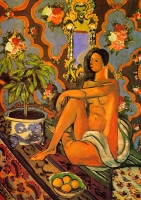
|
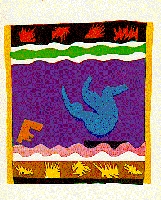
|

|
German ExpressionismThe Fauves were a French variant of expressionism, with a generally optimistic view of life. There are a number of variants of expressionism in Germany; however, most of the artists involved in these expressionist movements treated themes of serious religious and social import. The styles are similar, with often violent color, simplified forms, flattened shapes, and spaceless environments.
|
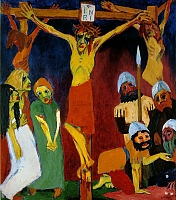
|
Emile Nolde (1867-1956)
The Crucifixion, 1912Nolde has treated this emotional subject in a very dramatic way, no doubt recalling earlier German painting. (See, for example, Matthias Grünwald's The Crucifixion, 1515.) Distortions of form and jarring colors are part of the expressionist vocabulary. |
Whereas Nolde treated primarily religious themes, Ernst Ludwig Kirchner dealt with social themes, some prefiguring Germany's involvement in war, some responding to the aftermath.Self Portrait with a Model, 1910-26 |
 |
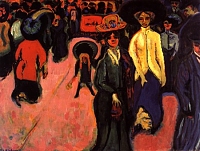
|
 |
Ernst Ludwig Kirchner (1880-1938)
The Street, 1907 and Two Women in the Street, 1914Not only are the jagged forms and bold colors expressive, the haunted faces of the people suggest a world coming apart. |
Although a number of German artists were important in these expressionist movements, the last artist we will examine is a graphic artist and sculptor, a woman whose career spans both the First and Second World War and who suffered the loss of a son in the former and a grandson in the latter.
|
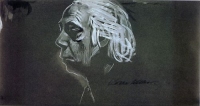
|

|
Käthe Kollwitz (1867-1945)
Self PortraitsThroughout her career, Kollwitz examined her own face; it is always anguished and suffering--never glamorized. |
Art for Kollwitz was a political tool; in her expressive and powerful graphic works, she sympathized with the poor and downtrodden and protested against war.Left: Woman and Dead Child, 1903; center: Never again War, 1924; right: Seed for the Planting Shall Not be Ground Up, 1942
|
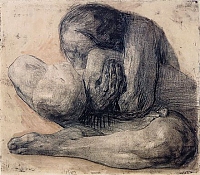
|
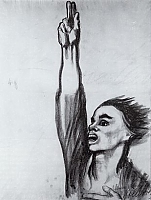
|
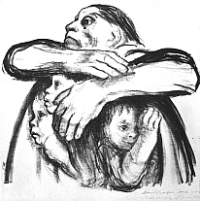
|
| Continue here for examples of modern art. |














